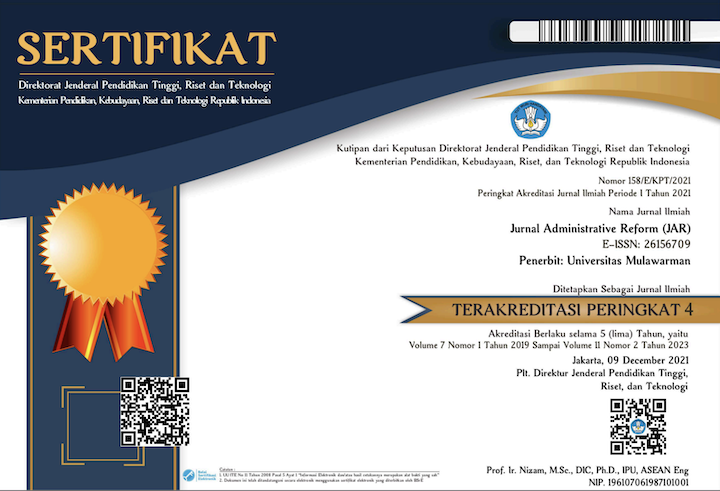Kapasitas Kelembagaan dalam Penanganan Bencana di Provinsi Banten
Abstract
Dalam upaya untuk meningkatkan tata kelola dan penanganan bencana, peran penting kapasitas kelembagaan seperti BPBD Provinsi Banten merupakan suatu keniscayaan, akan tetapi beberapa permasalahan dan isu isu strategis penanganan bencana masih dihadapi BPBD Provinsi Banten seperti masih terbatasnya sumber daya manusia, belum terintegrasi dan terstandarisasinya mekanisme/sistem pelaporan data dan informasi kebencanaan, belum lengkapnya pedoman dan dokumen penyelenggaraan penanggulangan bencana, masih terbatasnya ketersediaan logistic guna memenuhi kebutuhan dasar masyarakat terdampak bencana. Metode penelitian ini menggunakan pendekatan kualitatif. Teknik pengumpulan data dalam penelitian ini menggunakan observasi dan wawancara. Teknik dan prosedur pengambilan informan menggunakan purposive sampling sebagai salah satu elemen inti dari penelitian kualitatif yang tertuju pada informan yang memiliki informasi untuk dipelajari secara mendalam. Jumlah informan dalam penelitian ini berjumlah 7 orang yang berasal dari aparatur sipil negara Kantor BPBD, relawan Palang Merah Indonesia (PMI) Provinsi Banten dan komunitas masyarakat. Uji keabsahan data menggunakan teknik triangulasi sumber data wawancara dan observasi. Temuan penelitian menunjukkan bahwa faktor-faktor strategis kepemimpinan, komunikasi efektif, kepemimpinan berbasis komunitas atau masyarakat dalam tata kelola bencana dapat menjadi opsi dan pilihan penguatan kapasitas kelembagaan.
Kata Kunci: Kapasitas Kelembagaan, Penanganan Bencana, BPBD, Provinsi Banten
Full Text:
PDFReferences
Abenir, M. A. D., Manzanero, L. I. O., & Bollettino, V. (2022). Community-based leadership in disaster resilience: The case of small island community in Hagonoy, Bulacan, Philippines. International Journal of Disaster Risk Reduction, 71(December 2021), 102797. https://doi.org/10.1016/j.ijdrr.2022.102797
Aldrich, D. P. (2012). Building resilience: Social capital in post-disaster recovery. Chicago, USA; London, UK: The University of Chicago Press.
Andrew, S. A., Bacot, H., & Craw, M. (2020). A Multiorganizational Cooperation Framework for Neighborhood Disaster Resilience. State and Local Government Review, 52(1), 53–66. https://doi.org/10.1177/0160323X19898516
Annang, L. U. C. Y., Wilson, S., Tinago, C., Wright Sanders, L., Bevington, T., Carlos, B., Cornelius, E., & Svendsen, E. (2016). Photovoice: Assessing the Long-Term Impact of a Disaster on a Communitys Quality of Life. Qualitative Health Research, 26(2), 241–251. https://doi.org/10.1177/1049732315576495
Babu, S. C., De Pinto, A., & Paul, N. (2019). Strengthening Institutional Capacity for Disaster Management and Risk Reduction through Climate-Resilient Agriculture. International Food Policy Research Institute (IFPRI), 1(June), 270–289.
Boedhi. (2000). Pengembangan Organisasi: Upaya Dalam Meningkatkan Kinerja Organisasi. Jakarta: FISIP UT.
Bolden, R., & Kirk, P. (2008). Transforming communities through leadership development: a pan-African example. International Journal of Cross Cultural Management, 9(1), 69–86. http://hdl.handle.net/10036/30834
Celikler, J. M., & Kern, E. M. (2022). Factors influencing communication structures and processes in disaster management teams – Fields of action and design options. International Journal of Disaster Risk Reduction, 78(December 2021), 103153. https://doi.org/10.1016/j.ijdrr.2022.103153
Chakraborty, T., & Saha, R. (2017). Proactive and Reactive Role of Human Resource Professionals in an Aftershock Management. Training & Development Journal, 8(1), 1. https://doi.org/10.5958/2231-069x.2017.00001.4
Chen, F., Shirazi, Z., & Wang, L. (2021). Building scientific capacity in disaster risk reduction for sustainable development. Cultures of Science, 4(1), 40–54. https://doi.org/10.1177/20966083211017330
Creswell, J. W., & Creswell, J. D. (2018). Research Design Qualitative, Quantitative and Mixes Methods Approaches. In F. Edition (Ed.), Angewandte Chemie International Edition, 6(11), 951–952. SAGE Publication, Inc .
Crosweller, M. (2022). Disaster management and the need for a relational leadership framework founded upon compassion, care, and justice. Climate Risk Management, 35. https://doi.org/10.1016/j.crm.2022.100404
Dewa, O., Makoka, D., & Ayo-Yusuf, O. A. (2021). Assessing Capacity and Implementation Status of the Disaster Risk Management Strategy for Health and Community Disaster Resilience in Malawi. International Journal of Disaster Risk Science, 12(5), 673–688. https://doi.org/10.1007/s13753-021-00369-z
Djalante, R., Holley, C., & Thomalla, F. (2011). Adaptive Governance and Managing Resilience to Natural Hazards. International Journal of Disaster Risk Science, 2(4), 1–14. https://doi.org/10.1007/s13753-011-0015-6
Dwiningrum, S. I. A. (2017). Developing school resilience for disaster mitigation: a confirmatory factor analysis. Disaster Prevention and Management, 26(4), 437–451. https://doi.org/10.1108/DPM-02-2017-0042
Efendy, Z., Salju, S., Surullah, M., & Sapar, S. (2022). The Impact of Human Resources Capacity and Policy on Disaster Preparedness. Quantitative Economics and Management Studies, 3(1), 142–150. https://doi.org/10.35877/454ri.qems909
Goenjian, A. K., Roussos, A., Steinberg, A. M., Sotiropoulou, C., Walling, D., Kakaki, M., & Karagianni, S. (2011). Longitudinal study of PTSD, depression, and quality of life among adolescents after the Parnitha earthquake. Journal of Affective Disorders, 133(3), 509–515. https://doi.org/10.1016/j.jad.2011.04.053
Grindle, M. S. (1997). Getting Good Government: Capacity Building The Public Sector of Developing Countries. Boston MA: Harvard Institute For International Development.
Grossman, V. A. (2020). Leadership Essentials During a Disaster. Journal of Radiology Nursing, 39(3), 156–157. https://doi.org/10.1016/j.jradnu.2020.04.006
Heazle, M., Tangney, P., Burton, P., Howes, M., Grant-Smith, D., Reis, K., & Bosomworth, K. (2013). Mainstreaming climate change adaptation: An incremental approach to disaster risk management in Australia. Environmental Science and Policy, 33, 162–170. https://doi.org/10.1016/j.envsci.2013.05.009
Undang-Undang Republik Indonesia Nomor 24 tentang Penanggulangan Bencana, (2007).
Indudewi, D. (2009). Pengaruh Sasaran Jelas dan Terukur, Insentif, Desentralisasi dan Pengukuran Kinerja terhadap Kinerja Organisasi (Studi Empiris pada SKPD dan BUMD Kota Semarang). Pasca Sarjana Universitas Diponegoro.
Ireni-Saban, L. (2013). Challenging Disaster Administration: Toward Community-Based Disaster Resilience. Administration and Society, 45(6), 651–673. https://doi.org/10.1177/0095399712438375
Khan, M. A., & Ali, A. J. (2015). Do non-governmental organisations’ socio-economic and training programmes improve disaster prevention capacity of their beneficiaries? International Social Work, 58(3), 401–420. https://doi.org/10.1177/0020872815570074
Lorenzoni, N., Stühlinger, V., Stummer, H., & Raich, M. (2020). Long-term impact of disasters on the public health system: A multi-case analysis. International Journal of Environmental Research and Public Health, 17(17), 1–17. https://doi.org/10.3390/ijerph17176251
Maan, Y. A., & Jameel, M. (2021). The Role of Institutions in Disaster Risk Management and Mitigation in Punjab Pakistan. Indian Journal of Economics and Business, 20(1), 269–279.
Mao, Y. (2021). Political institutions, state capacity, and crisis management: A comparison of China and South Korea. International Political Science Review, 42(3), 316–332. https://doi.org/10.1177/0192512121994026
Medel, K., Kousar, R., & Masood, T. (2020). A collaboration–resilience framework for disaster management supply networks: a case study of the Philippines. Journal of Humanitarian Logistics and Supply Chain Management, 10(4), 509–553. https://doi.org/10.1108/JHLSCM-09-2019-0066
Milen, A. (2001). What do we know about capacity building? An overview of existing knowledge and good practice. https://doi.org/10.3109/10641969009073509
Miles, M. B., Huberman, M. A., & Saldaña, J. (2014). Qualitative Data Analysis, A Methods Sourcebook. In Qualitative Data Analysis A Methods Sourcebook (3 ed.). SAGE Publications Inc.
Nirupama, N. (2013). Disaster risk management In Encyclopedia of natural hazards. Dordrecht: Springer.
Oktari, R. S., Munadi, K., Idroes, R., & Sofyan, H. (2020). Knowledge management practices in disaster management: Systematic review. International Journal of Disaster Risk Reduction, 51(August), 101881. https://doi.org/10.1016/j.ijdrr.2020.101881
Owusu-Sekyere, E., Adjuik, R. Y., & Wedam, E. (2017). The Central Medical Store Fire Disaster: A Test for Institutional Compliance in Disaster Prevention in Ghana. SAGE Open, 7(2). https://doi.org/10.1177/2158244017699528
Paltemaa, L. (2017). China’s changing disaster management regime. China Information, 31(3), 284–303. https://doi.org/10.1177/0920203X17726611
Patton, M. Q. (2002). Two Decades of Developments in Qualitative Inquiry: A Personal, Experiential Perspective. Qualitative Social Work, 1(3), 261–283. https://doi.org/10.1177/1473325002001003636
Propper, C., & Wilson, D. (2003). The Use and Usefulness of Performance Measures in the Public Sector. In Oxford Review of Economic Policy (Vol. 19, Nomor 2). https://doi.org/10.1093/oxrep/19.2.250
Rafiey, H., Momtaz, Y. A., Alipour, F., Khankeh, H., Ahmadi, S., Khoshnami, M. S., & Haron, S. A. (2016). Are older people more vulnerable to long-term impacts of disasters? Clinical Interventions in Aging, 11, 1791–1795. https://doi.org/10.2147/CIA.S122122
Rakhman, C. U., Kharisma, L., & Suryadana, M. L. (2021). Combination of Transformational and Community-Based Leadership Model in the Development of Pujon Kidul Tourism Village, Indonesia. Journal of Leadership in Organizations, 3(2), 122–136. https://doi.org/10.22146/jlo.64188
Romero-Lankao, P., Hughes, S., Rosas-Huerta, A., Borquez, R., & Gnatz, D. M. (2013). Institutional capacity for climate change responses: An examination of construction and pathways in Mexico City and Santiago. Environment and Planning C: Government and Policy, 31(5), 785–805. https://doi.org/10.1068/c12173
Rongalaha, J. R. (2015). Manfaat Pemberian Insentif dalam Meningkatkan Kinerja Pegawai di Perpustakaan UNIKA De La Salle Manado. e-Journal “ Acta Diurna,” IV(4).
Rumalatu, G. A., & Waelauruw, A. T. (2021). Dampak Insentif, Desentraliasi dan Sistim Pengendalian Internal Terhadap Kinerja Pegawai. Public Policy (Jurnal Aplikasi Kebijakan Publik & Bisnis), 2(1), 21–36. https://doi.org/10.51135/publicpolicy.v2.i1.p21-36
Sapat, A., Esnard, A. M., & Kolpakov, A. (2019). Understanding Collaboration in Disaster Assistance Networks: Organizational Homophily or Resource Dependency? American Review of Public Administration, 49(8), 957–972. https://doi.org/10.1177/0275074019861347
Shah, I., Eali, N., Alam, A., Dawar, S., & Dogar, A. A. (2020). Institutional arrangement for disaster risk management: Evidence from Pakistan. International Journal of Disaster Risk Reduction, 51(July), 101784. https://doi.org/10.1016/j.ijdrr.2020.101784
Shah, S. S., & Rana, I. A. (2023). Institutional challenges in reducing disaster risks in the remote city of Hindukush-Karakorum-Himalayan (HKH) region, Pakistan. International Journal of Disaster Risk Reduction, 88(June 2022), 103581. https://doi.org/10.1016/j.ijdrr.2023.103581
Sharma, S. (2021). Exploring Disaster Mitigation in India: A Financial Viewpoint. Emerging Economy Studies, 7(1), 7–22. https://doi.org/10.1177/23949015211057915
Skrimizea, E., Bakema, M., McCann, P., & Parra, C. (2021). Disaster governance and institutional dynamics in times of social-ecological change: Insights from New Zealand, the Netherlands and Greece. Applied Geography, 136(January), 102578. https://doi.org/10.1016/j.apgeog.2021.102578
Slepski, L. A., Lavin, R. P., & Veenema, T. G. (2018). Leadership and Coordination in Disaster Health Care Systems: The U.S. National Response Framework. In Disaster Nursing and Emergency Preparedness for Chemical, Biological, and Radiological Terrorism and other Hazards (4th ed.). (Nomor November 2015). New York: Springer Publishing. https://doi.org/10.1891/9780826108654.0002
Sun, X., Chang-Richards, A. Y., Kleinsman, T., & Innes, A. (2021). Improving human resource mobilisation for post-disaster recovery: A New Zealand case study. International Journal of Disaster Risk Reduction, 52(December 2020), 101998. https://doi.org/10.1016/j.ijdrr.2020.101998
Sururi, A. (2016). Inovasi Kebijakan Publik (Tinjauan Konseptual dan Empiris). Sawala Jurnal Administrasi Negara, 4(September-Desember 2016), 1–14.
UNDRR. (2022). Global Assessment Report on Disaster Risk Reduction: Our World at Risk: Transforming Governance for a Resilient Future. In GLobal Assessment Report on Disaster Risk Reduction. Un Office fo Disaster Risk Reduction (UNDRR).
UNISDR. (2009). Terminology on Disaster Risk Reduction, United Nations International Strategy for Disaster Reduction. In United Nation. https://doi.org/10.4324/9781351138444-36
Vardarlıer, P. (2016). Strategic Approach to Human Resources Management During Crisis. Procedia - Social and Behavioral Sciences, 235(October), 463–472. https://doi.org/10.1016/j.sbspro.2016.11.057
Verbeeten, F. H. M. (2008). Performance management practices in public sector organizations: Impact on performance. Accounting, Auditing and Accountability Journal, 21(3), 427–454. https://doi.org/10.1108/09513570810863996
Whittle, S. R. (2011). Capacity Building What the Literature Tells Us. The Centre for Effective Services, Dublin. https://www.advance-he.ac.uk.
WHO/EHA. (2002). Disasters & Emergencies Definitions. In WHO/EHA Training package (Nomor March). WHO/EHA Panafrican Emergency Training Centre, Addis Ababa. http://apps.who.int/disasters/repo/7656.pdf
Yin, R. K. (2014). Case Study Research : design and methods (Fifth Edit). SAGE Publications Inc.
Zhang, X., Yi, L., & Zhao, D. (2013). Community-based disaster management: A review of progress in China. Natural Hazards, 65(3), 2215–2239. https://doi.org/10.1007/s11069-012-0471-3
DOI: http://dx.doi.org/10.30872/jar.v11i1.10540
Refbacks
- There are currently no refbacks.
Copyright (c) 2023 Jurnal Administrative Reform

This work is licensed under a Creative Commons Attribution-NonCommercial-ShareAlike 4.0 International License.
Jurnal Administrative Reform (JAR)
pISSN: 2337-7542 | eISSN: 2615-6709
Organized and Published by Magister Administrasi Publik - Fakultas Ilmu Sosial dan Ilmu Politik, Universitas Mulawarman
W : http://e-journals.unmul.ac.id/index.php/JAR/
E : jurnal.adm.reform@unmul.ac.id

Jurnal Administrative Reform (JAR) is licensed under a Creative Commons Attribution-ShareAlike 4.0 International License.




